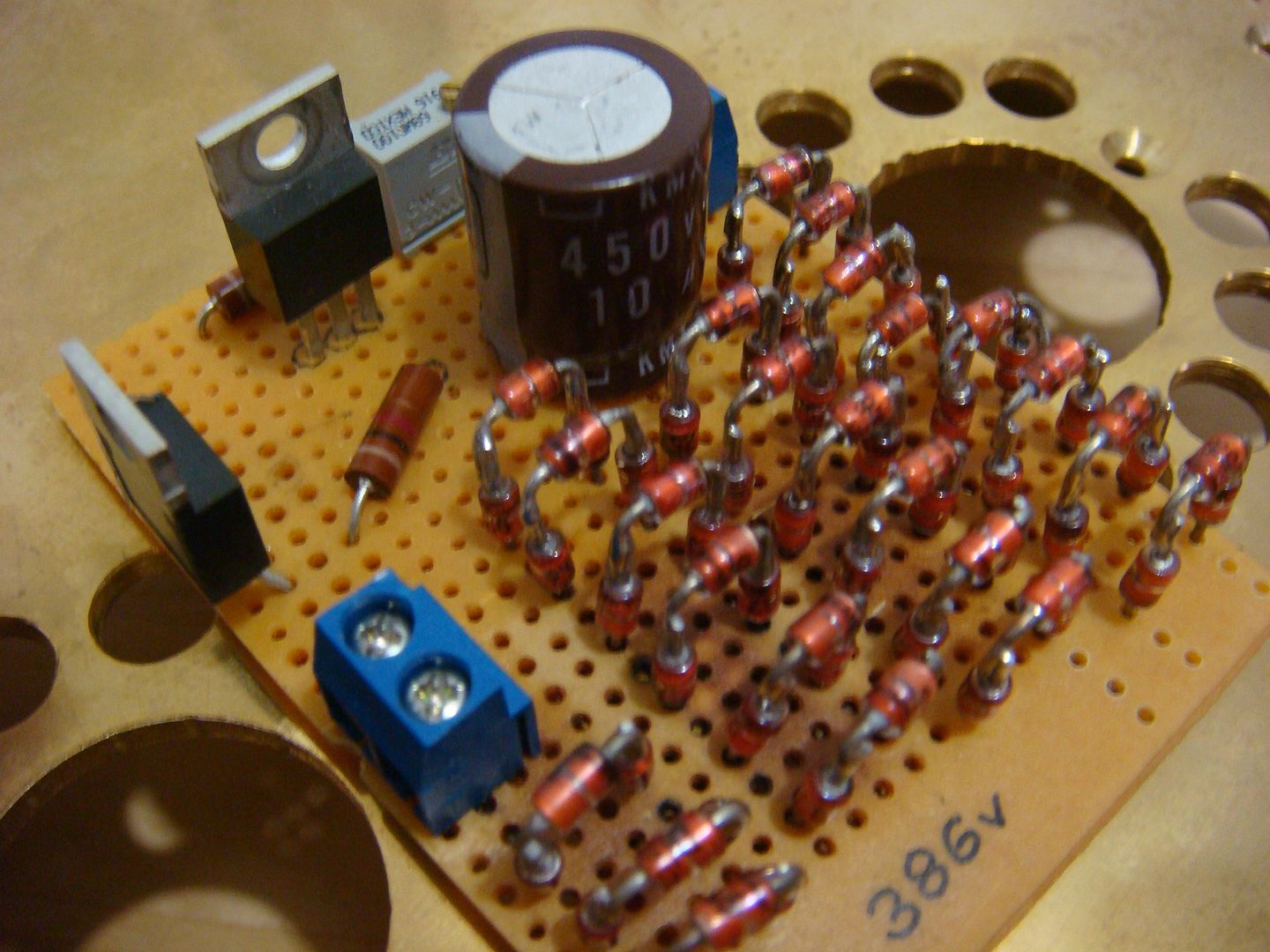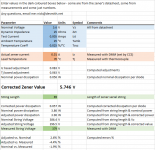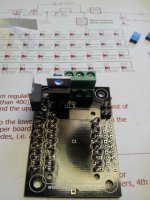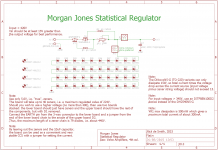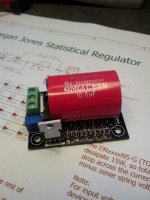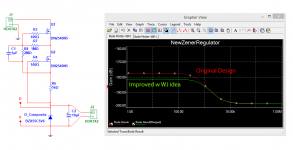Is there a theoretical or practical reason to omit the noise filtering capacitor(s)? Are they excessively large or ridiculously expensive?
AFAIK MJ uses a bypass capacitor. From the pictures Nick is using them as well.
Yes - I use a 400V, 10uF polypropylene (MKP) capacitor from Germany - they cost less than USD 5 and from my tests, are pretty good - they are also not too big... The whole PCB is 40 x 55mm.
This is all a bit of fun to see if there is any mileage in this approach. We like tinkering 🙂
I put in a bit of a discussion at the end of the thread on the subject of why I'm using 5V6 zeners and how temperature and zener current effect the actual rather than nominal zener voltage - small bit of maths there 🙂 (but I supply a spreadsheet to ease that!)
FWIW, the temperature coefficient (in %/°C) is not as significant effect as the zener current, Iz when calculating the actual rather than nominal zener voltage - again, see the discussion at the end of the thread.
This is all a bit of fun to see if there is any mileage in this approach. We like tinkering 🙂
I put in a bit of a discussion at the end of the thread on the subject of why I'm using 5V6 zeners and how temperature and zener current effect the actual rather than nominal zener voltage - small bit of maths there 🙂 (but I supply a spreadsheet to ease that!)
FWIW, the temperature coefficient (in %/°C) is not as significant effect as the zener current, Iz when calculating the actual rather than nominal zener voltage - again, see the discussion at the end of the thread.
Last edited:
MJ writes that zeners dissipate heat through their leads (which is logical), so one should not cut the leads short - I think that is why your zeners are so hot!
The zeners do get hot - mine run at about 90C with 20mA going through them, which is well within their SOA.
As stated, their main method of heat dissipation is via the leads (think about it - the leads are connected directly to the junction which is where the heat is generated), so they will get hot, even with 20mA going though them (they are rated for 70mA). To make matters slightly worse, mine are pretty densely packed, but they still are within SOA. You need to let air convect around them.
The comment about not being able to adjust the current with the 100R pot suggests either you've wired the CCS wrongly or you've got a dead FET.
As stated, their main method of heat dissipation is via the leads (think about it - the leads are connected directly to the junction which is where the heat is generated), so they will get hot, even with 20mA going though them (they are rated for 70mA). To make matters slightly worse, mine are pretty densely packed, but they still are within SOA. You need to let air convect around them.
The comment about not being able to adjust the current with the 100R pot suggests either you've wired the CCS wrongly or you've got a dead FET.
Last edited:
Thanks a lot, Guys! Appreciate your educational responses!
Puzzled why preamp works, despite the shortcoming. Sounding good and quite.
I've 379v coming out of the regulator from a string of 69 pcs. 5.6v zeners.
Cheers!
Puzzled why preamp works, despite the shortcoming. Sounding good and quite.
I've 379v coming out of the regulator from a string of 69 pcs. 5.6v zeners.
Cheers!
The nominal value of 69 x 5v6 zeners is 386V - To get a measured 379V is a bit odd - are they all the right way round?
Basically, with those zeners you expect the actual zener voltage to rise slightly with zener current (Iz) and with increasing temperature (though the effect is less than that of increasing Iz).
See the enclosed spreadsheet which models these effects pretty accurately - I would expect to see about 396V, assuming, conservatively that you've got about 10mA going through the zener chain and that they are running at about 70C.
Whatever happens, if these are BXZ55C5V6s, then the zener voltage should be ABOVE the nominal in this use case. If you are not using those, let us know what ones you are using...
Basically, with those zeners you expect the actual zener voltage to rise slightly with zener current (Iz) and with increasing temperature (though the effect is less than that of increasing Iz).
See the enclosed spreadsheet which models these effects pretty accurately - I would expect to see about 396V, assuming, conservatively that you've got about 10mA going through the zener chain and that they are running at about 70C.
Whatever happens, if these are BXZ55C5V6s, then the zener voltage should be ABOVE the nominal in this use case. If you are not using those, let us know what ones you are using...
Attachments
Thanks a lot, Guys! Appreciate your educational responses!
Puzzled why preamp works, despite the shortcoming. Sounding good and quite.
I've 379v coming out of the regulator from a string of 69 pcs. 5.6v zeners.
Cheers!
Hi Zekk
Based on the 396V figure by Nick (instead of 379V) and your problems with setting the CCS, I suspect you may have to little voltage for the CCS to work properly? A simple test would be to temporarely short out some 20 zeners (with a clip lead) and see what happens.
...and mine is "de Smith" - not as 'good' as "de Best", but not too bad either 🙂my surname is indeed 'de Best': neither misspelling nor snobbism! Ask SY!.
It's actually "Nicolaas van der Smet", but got a bit Anglicised...
I agree about Vin as a possible cause - he's also using an electrolytic rather than a polyprop and I hope that there is some headroom above 400V - I allow about 15V across the CCS to get reliable operation and to keep thermal losses in the CCS to a minimum.
Normally run between 10mA & 20mA through the zener string (as recommended by MJ) - the board I designed has test breakouts for both output and zener string current...
Attachments
Last edited:
Hi Nick,
many years ago I met SY and showed him an ID to prove the surname, therefore I refer to him 🙂
Are you sure about the "van der Smet"? The dutch word Smet means "stain", while Smit is the blacksmith.
Playing with the Statistical Regulator is also on my "to do" list. I will probably be using these point to point wiring boards, attaching zeners to both sides, and mounting the whole think to the chassis (so the board is vertical). With enough holes in the chassis the air flow would be quite ok to cool down the zeners.
Erik
many years ago I met SY and showed him an ID to prove the surname, therefore I refer to him 🙂
Are you sure about the "van der Smet"? The dutch word Smet means "stain", while Smit is the blacksmith.
Playing with the Statistical Regulator is also on my "to do" list. I will probably be using these point to point wiring boards, attaching zeners to both sides, and mounting the whole think to the chassis (so the board is vertical). With enough holes in the chassis the air flow would be quite ok to cool down the zeners.
Erik
Yeh - it is Smit - my bad 🙂
I have some of those p2p boards from the same seller - I bought a range of the different ones on offer.
They are Bakelite and very high quality with M3 brass inserts - extremely good value for money, IMHO.
http://stores.ebay.com/SOVCOM/Point...200648014&_sid=29574324&_trksid=p4634.c0.m322
I have some of those p2p boards from the same seller - I bought a range of the different ones on offer.
They are Bakelite and very high quality with M3 brass inserts - extremely good value for money, IMHO.
http://stores.ebay.com/SOVCOM/Point...200648014&_sid=29574324&_trksid=p4634.c0.m322
Last edited:
Hi Nick... Can you possibily sell me one completed and tested regulator?
I've screw-up all ten pcs. of my DN2540 and am wondering if they're actually fake or imitation stuff!? Why is it so fragile? Beleives there must be a rule of handling. How do you test it out before connecting to a high voltage supply?
Only success I've was using a single DN2540 to drive a pair of OD3.
What I really need is a regulated and stable 300vdc @ 50mA.
Thanks!
I've screw-up all ten pcs. of my DN2540 and am wondering if they're actually fake or imitation stuff!? Why is it so fragile? Beleives there must be a rule of handling. How do you test it out before connecting to a high voltage supply?
Only success I've was using a single DN2540 to drive a pair of OD3.
What I really need is a regulated and stable 300vdc @ 50mA.
Thanks!
DN2540N5-Gs are not expensive to buy from a reputable source (Farnell/RS/Newark/DigiKey/whatever)...
I only had 20 boards made up and I've got orders for over 30 now, so I'll have to have another batch made anyway - it will take at least two weeks for the boards to arrive, so if you can wait that long, you can have one.
However, I'm in the UK, so it'll take even longer to be re-shipped to you 🙂
My boards also only take 40 zeners, i.e. nominal 224VDC, so you'll need two boards - one just with zeners, the other with zeners and the CCS etc... The boards will need to be stacked about 10mm apart with spacers and have a couple of jumpers between them...
I only had 20 boards made up and I've got orders for over 30 now, so I'll have to have another batch made anyway - it will take at least two weeks for the boards to arrive, so if you can wait that long, you can have one.
However, I'm in the UK, so it'll take even longer to be re-shipped to you 🙂
My boards also only take 40 zeners, i.e. nominal 224VDC, so you'll need two boards - one just with zeners, the other with zeners and the CCS etc... The boards will need to be stacked about 10mm apart with spacers and have a couple of jumpers between them...
DN2540N5-Gs are not expensive to buy from a reputable source (Farnell/RS/Newark/DigiKey/whatever)...
I only had 20 boards made up and I've got orders for over 30 now, so I'll have to have another batch made anyway - it will take at least two weeks for the boards to arrive, so if you can wait that long, you can have one.
However, I'm in the UK, so it'll take even longer to be re-shipped to you 🙂
My boards also only take 40 zeners, i.e. nominal 224VDC, so you'll need two boards - one just with zeners, the other with zeners and the CCS etc... The boards will need to be stacked about 10mm apart with spacers and have a couple of jumpers between them...
Thanks, Nick! Reserve a pair for me, ya!
Meantime, the only regulation I've for my 801A pre is just a pair of OD3.
Yet, surprisingly, it still sounds good and I beleives it'll be even better with your regulator installed.
Regards.
Zekk
I have some users on another forum doing some initial build & listening tests for me...
It'll be a few weeks before I'm ready to release the kits...
It'll be a few weeks before I'm ready to release the kits...
Talking of glow tubes, I use a 0D3 right now for 150v supplied by a DN2540 for the first 4P1L stage of my amp.
Can anybody say how the Statistical reg actually compares to a glow tube in listening tests? Anybody compared them in the same setup.
I could build one myself and compare - haven't done that yet. Interested......
Can anybody say how the Statistical reg actually compares to a glow tube in listening tests? Anybody compared them in the same setup.
I could build one myself and compare - haven't done that yet. Interested......
You are welcome to join the POC we're doing over at AudioTalk - I have three experienced builders with good hearing (!!) already lined up - Andy - if you drop me a PM I'd welcome one more tester - I'm supplying a kit including PCB free to each tester...Talking of glow tubes, I use a 0D3 right now for 150v supplied by a DN2540 for the first 4P1L stage of my amp.
Can anybody say how the Statistical reg actually compares to a glow tube in listening tests? Anybody compared them in the same setup.
I could build one myself and compare - haven't done that yet. Interested......
The original thread is at MJ Statistical Regulator PCBs - audio-talk
Walt Jung showed how to improve the DN2540 CCS:
http://www.waltjung.org/PDFs/Sources_101_Letter_Revisit_0409.pdf
Just a couple more components:
http://www.waltjung.org/PDFs/Sources_101_Letter_Revisit_0409.pdf
Just a couple more components:
Attachments
- Home
- Amplifiers
- Tubes / Valves
- Statistical regulator from VA 4rd edition
